 W
WTunisian cuisine, the cuisine of Tunisia, consists of the cooking traditions, ingredients, recipes and techniques developed in Tunisia since antiquity. It is mainly a blend of Mediterranean and native Punics-Berber cuisine. Historically, Tunisian cuisine witnessed influence and exchanges with many cultures and nations like Italians, Andalusians, French and Arabs.
 W
WThe fricasse is a savory donut often filled with tuna, hard boiled egg, olives, harissa, and mashed potato condimented with turmeric usually purchased from a traditional Tunisian food vendor. It can be made at home or in fast food restaurants.
 W
WMechouia salad is a Tunisian salad. A very popular first course dish from Tunisia, a country in North Africa that appreciates spiciness, it is especially consumed in the summer, and is a grilled vegetable, tomatoes, peppers, onions and garlic salad, that may also contain eggplant. They are grilled in the oven or on the stove and then ground together, spiced, and then tuna and olive oil are added, and sometimes boiled eggs are placed for decoration.
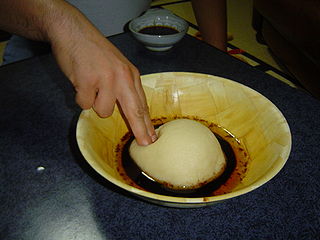 W
WAsida is a dish with origins from Arabia, made of a cooked wheat flour lump of dough, sometimes with added butter or honey. Similar in texture to gruel, it is eaten in many North African and Middle Eastern countries. The dish originated from the Oromo region in Ethiopia what they call Marca. It is considered one of the most popular desserts and traditional dishes in many Arab countries. Asida is particularly popular in Yemen, Sudan, Saudi Arabia, Kuwait, Algeria, Libya, Tunisia, Ethiopia, Eritrea, and Indonesia. As most traditional foods of these countries, it is usually eaten by hand, without the use of utensils. Often served during religious holidays such as Mawlid and Eid, it is also served during other traditional ceremonies, for example accompanying the birth of child, such as the ‘aqīqah, the cutting of the hair of a newborn seven days after birth.
 W
WAssidat Zgougou is a Tunisian dessert often prepared to celebrate the Mūled. It was originally made out of Aleppo pine, flour, milk, cream and nuts, that one variant of the dish is now known as "εasida Tunisia".
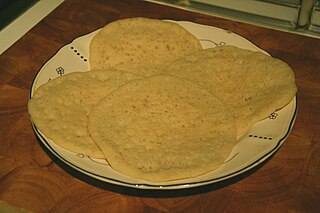 W
WBaghrir or beghrir (البغرير) is a pancake consumed in the Maghreb region. They are small, spongy and made with semolina or flour; when cooked correctly, they are riddled with tiny holes. The most common way to eat baghrir in Algeria and Morocco is by dipping them in a honey-butter mixture, but they can also be cut into wedges and served with jam. It is common to add raisins to the pancake as well. Baghrir are popular for breakfast, as a snack and for iftar during Ramadan.
 W
WBaklava is a layered pastry dessert made of filo pastry, filled with chopped nuts, and sweetened with syrup or honey. It was one of the most popular sweet pastries of Ottoman cuisine.
 W
WThe Baklouti pepper is a cultivar of the chili pepper found in the Maghreb region. It is the main ingredient in harissa, a very popular sauce in Tunisian cuisine made from smoked ground pepper. It is named after the city of Bekalta.
 W
WBambaloni, also referred to as bambalouni, is a sweet Tunisian donut. It can be made at home or bought from fast food shops. It is prepared with a flour dough fried in oil. The bambaloni is eaten sprinkled with sugar or soaked in honey. It can be eaten at any time of day. It is the Tunisian version of the Sfenj donut that is widely consumed throughout the Maghreb, which is also known as sfinz in Libya.
 W
WBorek or burek is a filled pastry made of a thin flaky dough such as filo with a variety of fillings, such as meat, cheese, spinach or potatoes. Boreks are mainly associated with the areas of the former Ottoman Empire, including the Balkans and the Caucasus, the Middle East, Eastern European and Central European countries, Northern Africa and Central Asia. A borek may be prepared in a large pan and cut into portions after baking, or as individual pastries. They are usually baked but some varieties can be fried. Borek is sometimes sprinkled with sesame or nigella seeds, and they may be served hot or cold.
 W
WBoukha is a distilled beverage produced from figs. It originated in the Tunisian Jewish community, where most of it is still produced.
 W
WBrik is the Tunisian version of borek, a stuffed filo pastry which is commonly deep fried. The best-known version is the egg brik, a whole egg in a triangular pastry pocket with chopped onion, tuna, harissa and parsley. With a slightly different shape, but with identical ingredients and method of preparation, the Tunisian brik is known in Algeria and Libya as bourek (بوراك). Brik is also very popular in Israel, due to the large Tunisian Jewish population there. It is often filled with a raw egg and herbs or tuna, harissa and olives and is sometimes served in a pita. This is also known as a boreeka.
 W
WBsisa is a typical Mediterranean food, based on flour of roasted barley which dates back to Roman times.
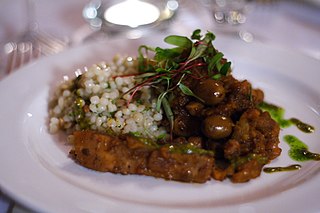 W
WChermoula or charmoula is a marinade and relish used in Algerian, Libyan, Moroccan and Tunisian cooking. It is traditionally used to flavor fish or seafood, but it can be used on other meats or vegetables.
 W
WChraime is a spicy fish stew with tomatoes from Libya. The name of the dish comes from the Arabic word for "hot".
 W
WCouscous is a North African dish of small steamed granules of rolled durum wheat semolina that is traditionally served with a stew spooned on top. Pearl millet, sorghum, Bulgur and other cereals can be cooked in a similar way in other regions and the resulting dishes are also sometimes called couscous.
 W
WA couscoussier is a traditional double-chambered food steamer used in Berber cuisine to cook couscous.
 W
WQurabiya is a shortbread-type biscuit, usually made with ground almonds. Versions are found in most countries of the former Ottoman Empire, with various different forms and recipes.
 W
WHarissa is a Tunisian hot chili pepper paste, the main ingredients of which are roasted red peppers, Baklouti peppers (بقلوطي), spices and herbs such as garlic paste, caraway seeds, coriander seeds, cumin and olive oil to carry the oil-soluble flavors. Rose harissa, made with rose petals, is also made.
 W
WKabkabou or Kabkabu is a fish and tomato stew traditionally prepared in Tunisia. The dish is well appreciated as it is relatively healthy and easy to prepare. It consists of a sauce in which fish steak is cooked, and capers, olives and lemons are added. Many species of fish are used, such as grouper, angel shark, tuna or mackerel. The main ingredients used in the preparation are onion, olive oil, tomato paste, garlic, harissa, salt, pepper, cumin, caper, lemon, pitted black olives, pitted green olives and saffron.
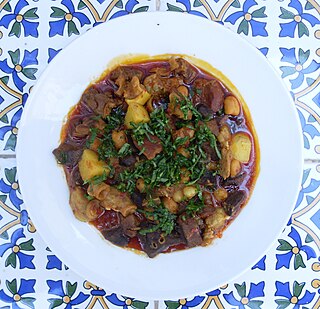 W
WKamounia, sometimes spelled Kamouneya, is a beef and liver stew prepared with cumin. It is a part of Sudanese cuisine and Tunisian cuisine. Lamb is also sometimes used as a primary ingredient, and additional spices are sometimes used. It is sometimes served with or atop cooked rice. Additional basic ingredients can include broth, garlic, olive oil and parsley.
 W
WLablabi or Lablebi is a Tunisian dish based on chick peas in a thin garlic and cumin-flavoured broth, served over small pieces of stale crusty bread. It is commonly eaten in inexpensive restaurants. Raw or soft-cooked egg is nearly always added to the hot soup mix, along with olive oil, harissa, additional cumin, capers, tuna, Baklouti pepper and sometimes olives, garlic and vinegar or lemon or lime juice. Further garnishes may include cilantro (coriander), parsley and scallions. A traditional, but rarer, version, hergma, is made with cows' trotters.
 W
WMakroudh is a cookie from the cuisines of the Maghreb and Malta. It is filled with dates and nuts or almond paste, that has a diamond shape – the name derives from this characteristic shape.
 W
WMatbukha is a Maghrebi dish of cooked tomatoes and roasted bell peppers seasoned with garlic and chili pepper. The name of the dish originates from Arabic and means "cooked" in Arabic. It is served as an appetizer, often as part of a meze table. Matbukha is popular across the Maghreb and in Israel, to where it was brought by Jewish immigrants from Morocco, Tunisia, Algeria, and Libya.
 W
WMesfouf, or masfouf is an Algerian, Moroccan and Tunisian dish which is a variant of couscous with finely rolled semolina and butter or olive oil.
 W
WMsoki is a Jewish soup traditional to Algerian and Tunisian Jews, and is most often eaten during feasts and in most, during the celebration of Passover.
 W
WOrgeat syrup is a sweet syrup made from almonds, sugar, and rose water or orange flower water. It was originally made with a barley-almond blend. It has a pronounced almond taste and is used to flavor many cocktails. Orgeat syrup is an important ingredient in the Mai Tai and many Tiki drinks.
 W
WOudnin el kadhi or wdinet el cadi are a type of pastry commonly found in Tunisia.
 W
WPalm wine, known by several local names, is an alcoholic beverage created from the sap of various species of palm tree such as the palmyra, date palms, and coconut palms. It is known by various names in different regions and is common in various parts of Africa, the Caribbean, South America, South Asia, Southeast Asia and Micronesia.
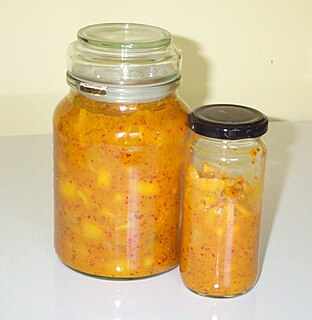 W
WPreserved lemon or lemon pickle is a condiment that is common in the cuisines of Indian subcontinent and North Africa. It's also found in 18th-century English cuisine.
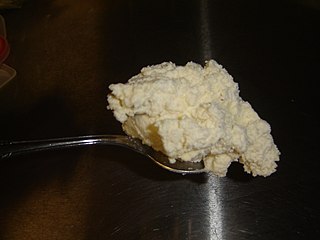 W
WThe rigouta is a Tunisian fresh soft cheese, produced mainly in the city of Béja. The cheese is a close relative to the Italian ricotta and is made with the whey of Sicilo-Sarda sheep.
 W
WRosette cookies are thin, cookie-like fritters made with iron molds that are found in many cultures. The name rosetbakkelser comes from Norwegian. Rosettes are crispy and typified by their lacy pattern. Rosettes are traditionally made during Christmas time. Rosette recipes are popular in the United States among families with Scandinavian ancestry.
 W
WSemolina is the coarse, purified wheat middlings of durum wheat mainly used in making couscous, pasta, and sweet puddings. The term semolina is also used to designate coarse middlings from other varieties of wheat, and sometimes other grains as well.
 W
WShakshouka is a Maghrebi dish of eggs poached in a sauce of tomatoes, olive oil, peppers, onion and garlic, commonly spiced with cumin, paprika and cayenne pepper. According to Joan Nathan, shakshouka originated in Ottoman North Africa in the mid-16th century after tomatoes were introduced to the region by Hernan Cortés as part of the Columbian exchange.
 W
WTaguella is a flat bread, the staple dish of Tuareg people living in the Sahara. It is a disk-shaped bread made from wheat flour and cooked buried underneath the hot sand and charcoal of a small fire. The bread is then broken up into small pieces and eaten with a meat sauce.
 W
WA tajine or tagine is a Berber dish, named after the earthenware pot in which it is cooked. It is also called maraq or marqa.
 W
WUmmak huriyya salad is a salad made up of carrots, onions, garlic, salt, spices, harissa, olive oil, lemon juice and then decorated with parsley, olives and eggs.
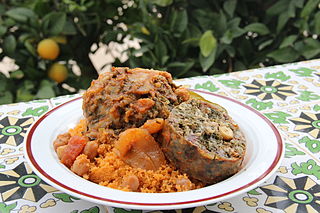 W
WUsban is a similar dish to haggis in Libyan cuisine. is a traditional kind of sausage in the Maghreb, stuffed with a mixture of rice, herbs, lamb, chopped liver and heart. This dish is usually served alongside the main meal of rice or couscous, often on special occasions.
 W
WZalabiyeh also known as Mutabaqa is a fritter or doughnut found in several cuisines across the Middle East and West Asia. The fritter version, similar to jalebi and funnel cake, is made from a semi-thin batter of wheat flour which is poured into hot oil and deep-fried. The earliest known recipe for the dish comes from a 10th-century Arabic cookbook and is made by pouring the batter through a coconut shell. Zalabiyeh is also the Arabic language term used by Mizrahi Jews for a deep-fried yeast dough, often topped with either honey or syrup, and known as burmuelos in Ladino.